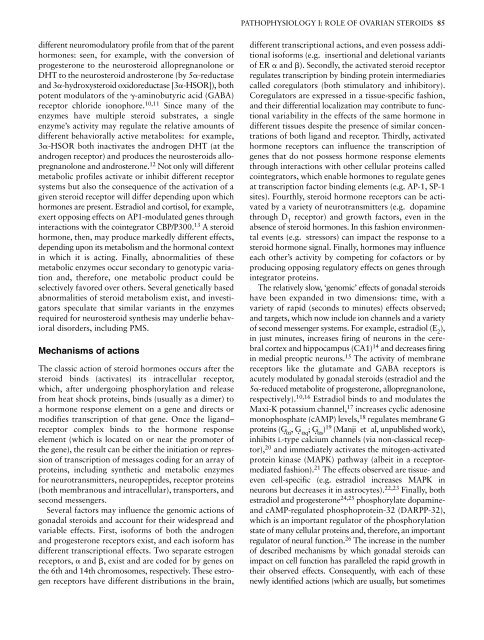Premenstrual Syndromes : PMS and PMDD - Rutuja :: The site ...
Premenstrual Syndromes : PMS and PMDD - Rutuja :: The site ...
Premenstrual Syndromes : PMS and PMDD - Rutuja :: The site ...
Create successful ePaper yourself
Turn your PDF publications into a flip-book with our unique Google optimized e-Paper software.
different neuromodulatory profile from that of the parent<br />
hormones: seen, for example, with the conversion of<br />
progesterone to the neurosteroid allopregnanolone or<br />
DHT to the neurosteroid <strong>and</strong>rosterone (by 5�-reductase<br />
<strong>and</strong> 3�-hydroxysteroid oxidoreductase [3�-HSOR]), both<br />
potent modulators of the �-aminobutyric acid (GABA)<br />
receptor chloride ionophore. 10,11 Since many of the<br />
enzymes have multiple steroid substrates, a single<br />
enzyme’s activity may regulate the relative amounts of<br />
different behaviorally active metabolites: for example,<br />
3�-HSOR both inactivates the <strong>and</strong>rogen DHT (at the<br />
<strong>and</strong>rogen receptor) <strong>and</strong> produces the neurosteroids allopregnanolone<br />
<strong>and</strong> <strong>and</strong>rosterone. 12 Not only will different<br />
metabolic profiles activate or inhibit different receptor<br />
systems but also the consequence of the activation of a<br />
given steroid receptor will differ depending upon which<br />
hormones are present. Estradiol <strong>and</strong> cortisol, for example,<br />
exert opposing effects on AP1-modulated genes through<br />
interactions with the cointegrator CBP/P300. 13 A steroid<br />
hormone, then, may produce markedly different effects,<br />
depending upon its metabolism <strong>and</strong> the hormonal context<br />
in which it is acting. Finally, abnormalities of these<br />
metabolic enzymes occur secondary to genotypic variation<br />
<strong>and</strong>, therefore, one metabolic product could be<br />
selectively favored over others. Several genetically based<br />
abnormalities of steroid metabolism exist, <strong>and</strong> investigators<br />
speculate that similar variants in the enzymes<br />
required for neurosteroid synthesis may underlie behavioral<br />
disorders, including <strong>PMS</strong>.<br />
Mechanisms of actions<br />
<strong>The</strong> classic action of steroid hormones occurs after the<br />
steroid binds (activates) its intracellular receptor,<br />
which, after undergoing phosphorylation <strong>and</strong> release<br />
from heat shock proteins, binds (usually as a dimer) to<br />
a hormone response element on a gene <strong>and</strong> directs or<br />
modifies transcription of that gene. Once the lig<strong>and</strong>–<br />
receptor complex binds to the hormone response<br />
element (which is located on or near the promoter of<br />
the gene), the result can be either the initiation or repression<br />
of transcription of messages coding for an array of<br />
proteins, including synthetic <strong>and</strong> metabolic enzymes<br />
for neurotransmitters, neuropeptides, receptor proteins<br />
(both membranous <strong>and</strong> intracellular), transporters, <strong>and</strong><br />
second messengers.<br />
Several factors may influence the genomic actions of<br />
gonadal steroids <strong>and</strong> account for their widespread <strong>and</strong><br />
variable effects. First, isoforms of both the <strong>and</strong>rogen<br />
<strong>and</strong> progesterone receptors exist, <strong>and</strong> each isoform has<br />
different transcriptional effects. Two separate estrogen<br />
receptors, � <strong>and</strong> �, exist <strong>and</strong> are coded for by genes on<br />
the 6th <strong>and</strong> 14th chromosomes, respectively. <strong>The</strong>se estrogen<br />
receptors have different distributions in the brain,<br />
PATHOPHYSIOLOGY I: ROLE OF OVARIAN STEROIDS 85<br />
different transcriptional actions, <strong>and</strong> even possess additional<br />
isoforms (e.g. insertional <strong>and</strong> deletional variants<br />
of ER � <strong>and</strong> �). Secondly, the activated steroid receptor<br />
regulates transcription by binding protein intermediaries<br />
called coregulators (both stimulatory <strong>and</strong> inhibitory).<br />
Coregulators are expressed in a tissue-specific fashion,<br />
<strong>and</strong> their differential localization may contribute to functional<br />
variability in the effects of the same hormone in<br />
different tissues despite the presence of similar concentrations<br />
of both lig<strong>and</strong> <strong>and</strong> receptor. Thirdly, activated<br />
hormone receptors can influence the transcription of<br />
genes that do not possess hormone response elements<br />
through interactions with other cellular proteins called<br />
cointegrators, which enable hormones to regulate genes<br />
at transcription factor binding elements (e.g. AP-1, SP-1<br />
<strong>site</strong>s). Fourthly, steroid hormone receptors can be activated<br />
by a variety of neurotransmitters (e.g. dopamine<br />
through D 1 receptor) <strong>and</strong> growth factors, even in the<br />
absence of steroid hormones. In this fashion environmental<br />
events (e.g. stressors) can impact the response to a<br />
steroid hormone signal. Finally, hormones may influence<br />
each other’s activity by competing for cofactors or by<br />
producing opposing regulatory effects on genes through<br />
integrator proteins.<br />
<strong>The</strong> relatively slow, ‘genomic’ effects of gonadal steroids<br />
have been exp<strong>and</strong>ed in two dimensions: time, with a<br />
variety of rapid (seconds to minutes) effects observed;<br />
<strong>and</strong> targets, which now include ion channels <strong>and</strong> a variety<br />
of second messenger systems. For example, estradiol (E 2 ),<br />
in just minutes, increases firing of neurons in the cerebral<br />
cortex <strong>and</strong> hippocampus (CA1) 14 <strong>and</strong> decreases firing<br />
in medial preoptic neurons. 15 <strong>The</strong> activity of membrane<br />
receptors like the glutamate <strong>and</strong> GABA receptors is<br />
acutely modulated by gonadal steroids (estradiol <strong>and</strong> the<br />
5�-reduced metabolite of progesterone, allopregnanolone,<br />
respectively). 10,16 Estradiol binds to <strong>and</strong> modulates the<br />
Maxi-K potassium channel, 17 increases cyclic adenosine<br />
monophosphate (cAMP) levels, 18 regulates membrane G<br />
proteins (G.αi , G. αq ; G.αs )19 (Manji et al, unpublished work),<br />
inhibits L-type calcium channels (via non-classical receptor),<br />
20 <strong>and</strong> immediately activates the mitogen-activated<br />
protein kinase (MAPK) pathway (albeit in a receptormediated<br />
fashion). 21 <strong>The</strong> effects observed are tissue- <strong>and</strong><br />
even cell-specific (e.g. estradiol increases MAPK in<br />
neurons but decreases it in astrocytes). 22,23 Finally, both<br />
estradiol <strong>and</strong> progesterone 24,25 phosphorylate dopamine<strong>and</strong><br />
cAMP-regulated phosphoprotein-32 (DARPP-32),<br />
which is an important regulator of the phosphorylation<br />
state of many cellular proteins <strong>and</strong>, therefore, an important<br />
regulator of neural function. 26 <strong>The</strong> increase in the number<br />
of described mechanisms by which gonadal steroids can<br />
impact on cell function has paralleled the rapid growth in<br />
their observed effects. Consequently, with each of these<br />
newly identified actions (which are usually, but sometimes


